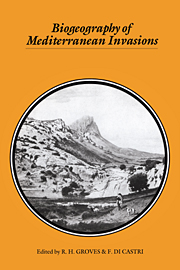Book contents
- Frontmatter
- Contents
- List of contributors
- Preface
- Part I Introduction
- Part II Historical background
- Part III Biogeography of taxa
- 7 Invasive plants of the Mediterranean Basin
- 8 Invasive vascular plants of California
- 9 Introduction of plants into the mediterranean-type climate area of Chile
- 10 Introduced plants of the fynbos biome of South Africa
- 11 Invasive plants of southern Australia
- 12 Life cycles of some Mediterranean invasive plants
- 13 Invasion processes as related to succession and disturbance
- 14 Is fire an agent favouring plant invasions?
- 15 Plant invasion and soil seed banks: control by water and nutrients
- 16 Invasion by annual brome grasses: a case study challenging the homoclime approach to invasions
- 17 Patterns of Pleistocene turnover, current distribution and speciation among Mediterranean mammals
- 18 Introduced mammals in California
- 19 Ecology of a successful invader: the European rabbit in central Chile
- 20 Mammals introduced to the mediterranean region of South Africa
- 21 Mammals introduced to southern Australia
- 22 Invasions and range modifications of birds in the Mediterranean Basin
- 23 Invasions in the mediterranean avifaunas of California and Chile
- 24 Birds introduced to the fynbos biome of South Africa
- 25 Species of introduced birds in mediterranean Australia
- Part IV Applied aspects of mediterranean invasions
- Part V Overview
- Index of scientific names
- Subject index
12 - Life cycles of some Mediterranean invasive plants
Published online by Cambridge University Press: 02 December 2009
- Frontmatter
- Contents
- List of contributors
- Preface
- Part I Introduction
- Part II Historical background
- Part III Biogeography of taxa
- 7 Invasive plants of the Mediterranean Basin
- 8 Invasive vascular plants of California
- 9 Introduction of plants into the mediterranean-type climate area of Chile
- 10 Introduced plants of the fynbos biome of South Africa
- 11 Invasive plants of southern Australia
- 12 Life cycles of some Mediterranean invasive plants
- 13 Invasion processes as related to succession and disturbance
- 14 Is fire an agent favouring plant invasions?
- 15 Plant invasion and soil seed banks: control by water and nutrients
- 16 Invasion by annual brome grasses: a case study challenging the homoclime approach to invasions
- 17 Patterns of Pleistocene turnover, current distribution and speciation among Mediterranean mammals
- 18 Introduced mammals in California
- 19 Ecology of a successful invader: the European rabbit in central Chile
- 20 Mammals introduced to the mediterranean region of South Africa
- 21 Mammals introduced to southern Australia
- 22 Invasions and range modifications of birds in the Mediterranean Basin
- 23 Invasions in the mediterranean avifaunas of California and Chile
- 24 Birds introduced to the fynbos biome of South Africa
- 25 Species of introduced birds in mediterranean Australia
- Part IV Applied aspects of mediterranean invasions
- Part V Overview
- Index of scientific names
- Subject index
Summary
In this chapter we will consider some life history traits, such as longevity and fecundity, dispersal in space and in time, and the type of reproductive system (inbreeding or outbreeding). Some of the factors which may act on these traits, as reviewed by Stearns (1976, 1977) and Charlesworth (1980), can be summarised as:
Perennial types (polycarpic or monocarpic) (Hart, 1977) are to be favoured if, because of environmental conditions, juvenile survival is low compared to adult survival (Michod, 1979), or alternatively, if the environmental conditions are less predictable during the juvenile stage than later in the life cycle (Murphy, 1968).
Perennial genotypes are also favoured in species in which population sizes are usually stable or decreasing, whilst annual types are favoured in species in which populations are increasing most of the time. As pointed out by Caswell (1982), however, no population is always increasing or stable, so that the result for a given genotype depends on the relative importance of phases of increase and decrease.
High dispersal rates are selected against within each population and selected for at the establishment of new populations. Van Valen (1971) and others (e.g. Slatkin & Wade, 1979; Olivieri & Gouyon, 1985) emphasised the importance of the rate of extinction on the evolutionary stable dispersal rate. We shall see subsequently that there is another important environmental factor which should also be considered.
- Type
- Chapter
- Information
- Biogeography of Mediterranean Invasions , pp. 145 - 158Publisher: Cambridge University PressPrint publication year: 1991
- 2
- Cited by

